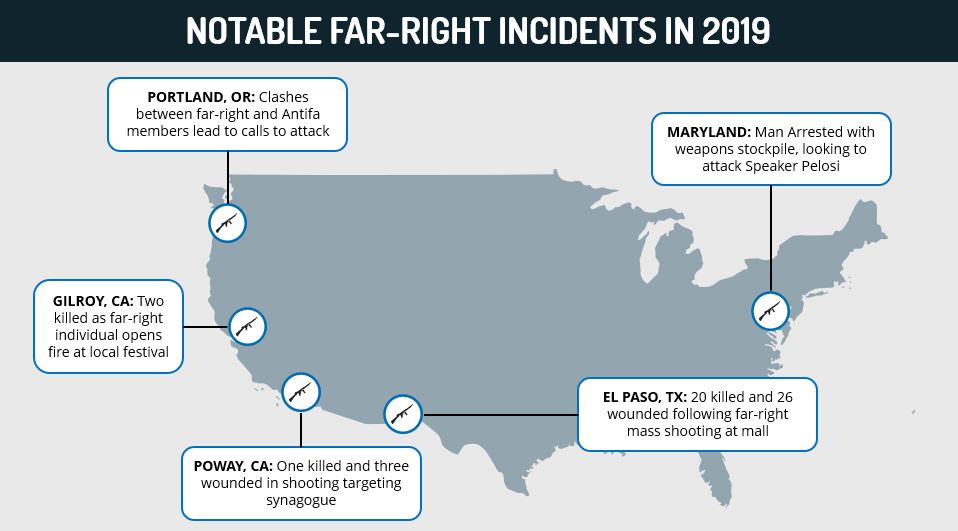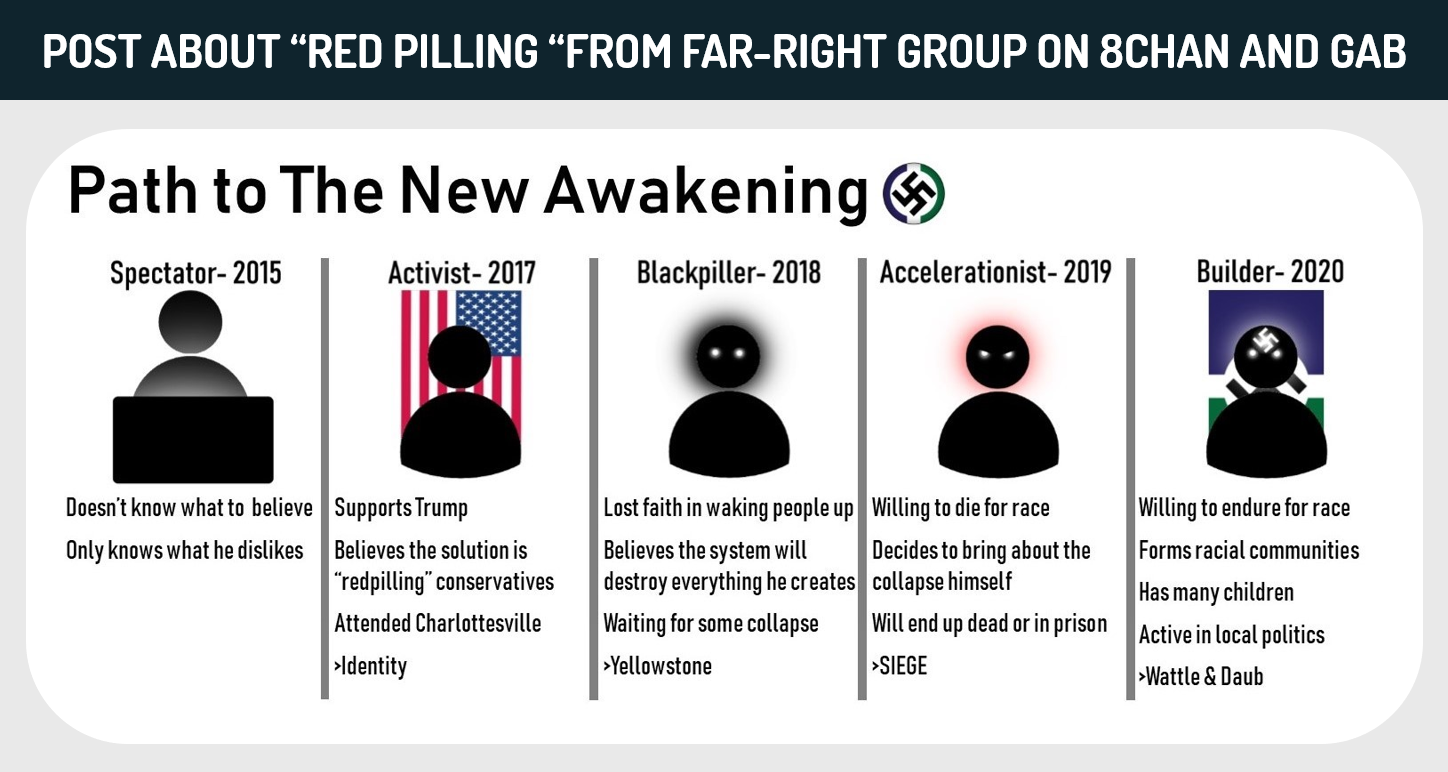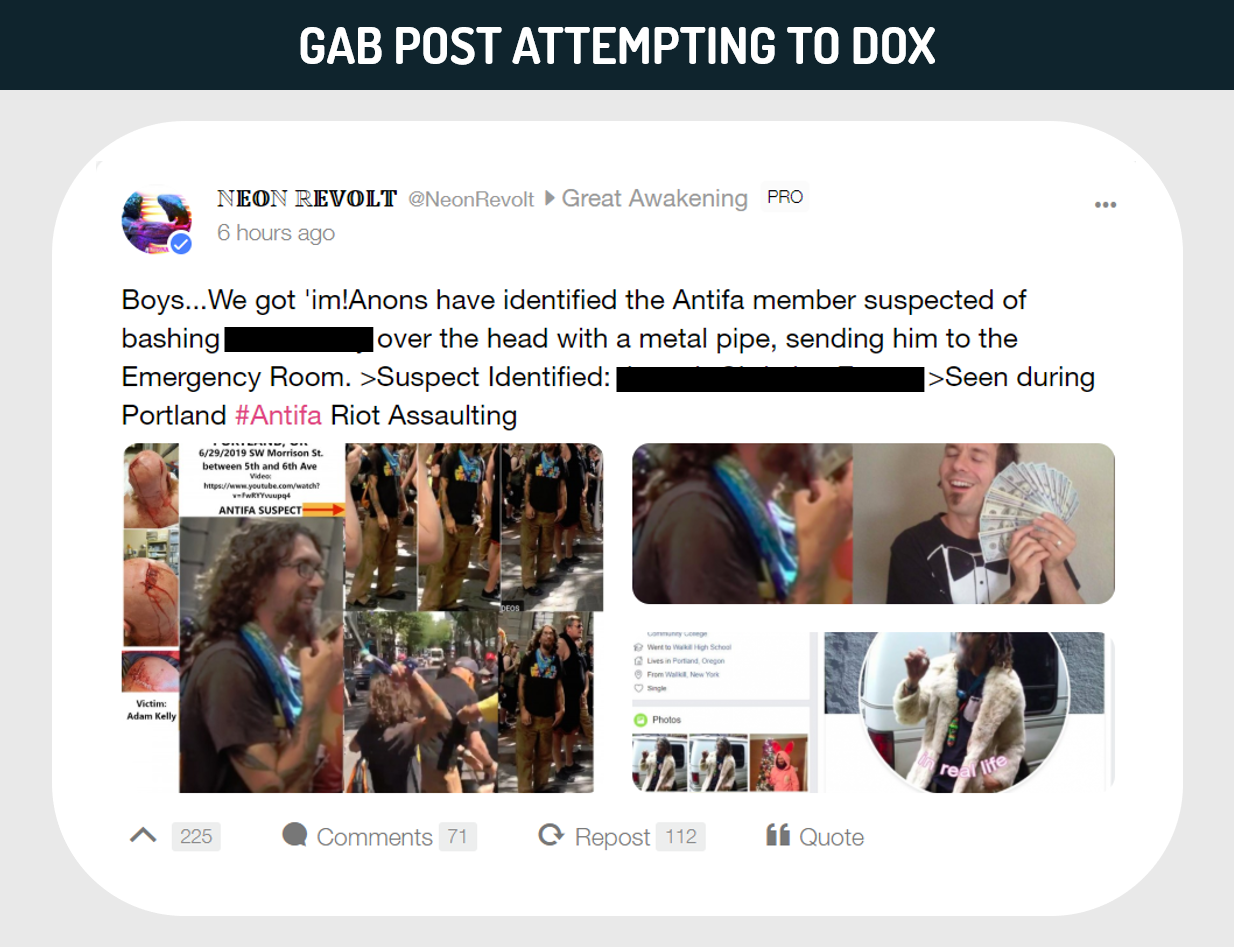Written and Edited by Saad Lambe and Ollie Wiltshire
Executive Summary
Far-right online communities have increasingly shifted towards planning and calling for militant attacks, demonstrating the increased threat from such forums.
Calls for attacks against traditional far-right targets, including Jewish and Muslim communities, have seen a significant increase.
Corporations aligning with perceived left-wing political views are frequently discussed in a violent context.
Attendees at left-wing rallies, particularly those with right-wing counter-protests, face an increased threat of being identified online and targeted.
Far-right attacks from lone wolves will take place in the coming months as a result of the uptick in online activity.
Increase awareness of threats on social media through the use of threat monitoring services.
Current Situation
On August 3, a man entered a large supermarket in El Paso, Texas and opened fire on shoppers, killing 20 and wounding 26. The shooter posted a manifesto on 8chan, which described his opposition to the ‘Latino takeover’ of Texas. While he disavowed both the Democratic and Republican party, the manifesto included terms such as ‘fake news’ popularized during President Donald Trump’s campaign. Additionally, he stated that he was inspired by the Christchurch, NZ shooter and echoed talking points of the conspiracy theory ‘the great replacement’, naming it as the reason he targeted Hispanic and Latino people.
Following the shooting, 8chan’s hosting provider, Cloudflare, dropped the website as a client due to it being a convergence point for militants, which is expected to disrupt access to the website. With the presence of multiple competitors in the market, reports state that this incident is unlikely to have a long-term impact on the website.
A far-right militant entered a festival in Gilroy, CA on July 29 with a semi-automatic weapon and opened fire on attendees leading to the death of two people. The shooter was killed in a confrontation with the police having asked his social media followers to read a far-right extremist book before committing the attack.
Federal Bureau of Investigation (FBI) director Christopher Wray stated on July 23 in a Senate Judiciary Committee hearing that a significant percentage of domestic militant suspects arrested had been linked to white supremacy, additionally stating that over 100 domestic militant arrests had taken place from October 2018 to July 2019.
Portland, Oregon witnessed clashes on June 29 between members of the anti-fascist Antifa group and the far-right Proud Boys group, leading to several injuries. A member of the Proud Boys threatened to kill Portland Mayor Ted Wheeler and a number of people on far-right forums rallied against what they perceived as ‘state-sanctioned violence’, calling for violence against people they identified as Antifa members.
On April 27, 2019, a gunman entered the Chabad of Poway synagogue in Poway, California and killed one person with a semi-automatic rifle and injured three others. He attempted to live stream a video of the shooting to Facebook but failed. He yelled anti-semitic slurs while entering and posted an anti-semitic manifesto on the far-right online forum 8chan before carrying out the attack. He had previously committed arson at a mosque and was allegedly inspired by the Christchurch shooter.
A Coast Guard Lieutenant, Christopher Paul Hasson, was arrested in Maryland on February 15, 2019, in the USA with a large stockpile of weapons, intending to commit an attack on a scale he claimed was ‘rarely seen in this country’. He identified as a white nationalist and had been collecting weapons since 2017. He planned to attack members of the Democratic Party, including House Speaker Nancy Pelosi, along with television anchors from several high-profile networks perceived as ‘liberal’ and being biased against the right-wing community.
Background
Far-right attacks in North America have increasingly involved a single perpetrator (lone-wolf), self-radicalized through online propaganda, involving ‘memes’ depicting migrants and people-of-color as invaders, posing a threat to the ‘white race’.
Individuals committing attacks and associated with far-right communities follow a path involving joking about attacks against certain target groups, which is usually applauded and reinforced by other members. They then begin stockpiling weapons, settling on a target, and researching the premises before executing the attack.
A large number of far-right militants were inspired by ideas espoused in Anders Behring Breivik’s manifesto used to justify his 2011 attacks in Norway and have released similar documents before attacks. This was highlighted by the Christchurch attacker, who posted his manifesto online on 8chan.
Far-right online communities have been instrumental in the dissemination of propaganda intended to establish the white race as ‘inherently superior’, as well as to push propaganda such as the ‘Great Replacement Theory’, which portrays Muslims attempting to convert a ‘Christian West’ into an Islamic homeland by sustained high-levels of migration.
Several far-right communities engage in ‘doxxing’, a term used to describe identifying an anonymous user or person’s personal details, in an attempt to intimidate, harass, and threaten the victim. While previously restricted to users online, members have begun posting images of left-wing activists at counter-protests in an attempt to identify and potentially harass and attack them.
Assessments & Forecast
Increased calls for militant attacks likely to heighten security threat against traditional far-right targets
There has been a notable increase in calls for attacks on traditional far-right targets, including Jewish and Muslim communities, on websites such as 8chan and Gab with a dominant far-right userbase, which have been used to post militant manifestos due to their relaxed content rules.
On far-right forums, calls for attacks are largely indirect and usually in response to events perceived as ‘anti right-wing’. Recruitment for potential militants begins by appealing to traditionally conservative issues including anti-immigrant sentiments and orthodox conceptions of the family, which later devolves into calls for forum users to join ‘state militias’ which have often been described as possessing a far-right leaning.
While Gab has occasionally enforced rules over direct threats, 8chan allows this content to be posted regardless of its nature. In this regard, 8chan is likely to grow as one of the primary modes of propaganda dissemination and calls to action for far-right extremists online. Such content will come in the form of ‘memes’ and short-form media, including images and gifs, allowing the ideology to easily embed itself within more palatable internet culture.
A common theme of conversation includes corporations perceived as aligning with left-wing issues, such as civil rights and diversity, along with social media and news corporations accused of bias against right-wing groups. These discussions largely take place in a violent setting, with accusations of being funded by secretive ‘anti-white’ groups. In this regard, this behavior demonstrates the increased threat faced by these companies from far-right individuals over their political views.
Calls against Jewish targets rely on a variety of anti-semitic tropes, attempting to instigate readers into stopping Jewish ‘influence’ in politics and socio-economic issues on the world stage. Certain key personalities, including George Soros, are frequently mentioned, implying a stronger focus towards committing violence against Jewish people in political, corporate, and community positions.
Muslim communities in the West are largely painted as ‘invaders’, using the great replacement theory which was mentioned by the Christchurch shooter. As such, calls for attacks specifically mention mosques and Muslim community centers in Western countries, designating them as potential targets.
In the Gilroy, CA shooting on July 29, the shooter posted on social media asking followers to read a far-right book, common in white-supremacist groups before committing the attack. This highlights an ongoing trend among militants, attempting to clarify their intentions for the attack, likely brought on by multiple ‘white-power’ movements with differing goals.
As seen in the Christchurch shooter’s manifesto, many online calls will include references to ‘internet culture’ known as dog-whistle tactics, in which content is used to mean different things to the general public and the far-right audience. Given that a large number of ‘memes’ and culture-specific images have been created to evoke racist imagery within these communities, it is often used to subtly encourage violence towards groups. This is often termed as ‘redpilling’, a phrase used by online far-right communities to indicate the ‘conversion’ of a casual user into one who fits the profile of a traditional far-right user.
The recent wave of shootings served to highlight the trend of far-right incidents trickling down from casual hate-speech online to real-life violence. While the majority may not act based on hate-speech, the inherent nature of such closed-off communities attracts psychologically unstable individuals who are increasingly susceptible to these forms of propaganda.
Attempts to identify (dox) protesters and call for violence at left-wing rallies likely to grow, including dissemination of false information
With both left-wing and right-wing events predominantly being promoted and discussed online, there will likely continue to be an increase in discussions centered around what takes place at these rallies.
Far-right communities have included inflammatory content, especially false warnings about Antifa and other left-wing groups planning to commit attacks at right-wing rallies and calling for attendees to carry weapons to protect themselves which is likely to lead to further clashes at right-wing rallies going forward.
Some users on the social media website Reddit’s now restricted ‘The_Donald’ forum attempted to create a document containing personal details of individuals believed to be ‘anti-Trump’. This document featured generic information, including age and vague location, but in some cases, it featured details including ethnicity, sexual orientation, and home and business addresses. The details imply that members of the LGBT community and other minority groups are priority targets for these radical factions.
Most recently echoed in a Portland, OR rally by a far-right group called the Proud Boys, comments made on Gab included screenshots of individuals’ social media profiles who were perceived as left-wing activists, descriptions of their workplace, as well as photos of a rope meant to call for lynchings. Some allegedly left-wing members identified were unlikely t be members of Antifa, instead, such false-positives were likely targeting unaffiliated counter-protesters. This behavior reinforces the danger presented to civilians unconnected to both Antifa and other left-wing groups who may be misidentified through these actions and targeted for attacks.
Journalists have increasingly been targeted in recent years, especially those deemed as left-wing. Far-right users, in particular, believe in a larger conspiracy against right-wing groups among “mainstream” media. This was demonstrated in the case of the coast guard arrest, who planned to attack several left-wing commentators due to their perceived bias. Therefore, journalists are likely to continue being the target of online harassment, with the increased possibility of threats online devolving into physical violence.
Based on previous attacks, instances of violence directed towards ‘doxxed’ individuals may include pipe bombs, possibly containing TATP often employed by Islamic State (IS) members, with the wide availability of manufacturing instructions online.
Recommendations
Public, private, and third sector organizations are advised to increase their awareness of threats on social media through the use of threat monitoring services. Increased awareness of an organization’s political footprint and perceptions from fringe online groups can help uncover potential violent actors and plots before they occur.




